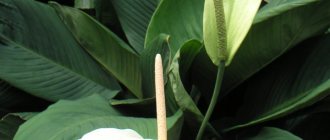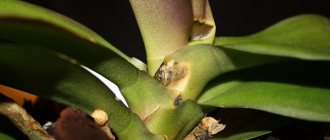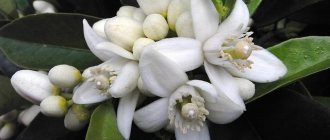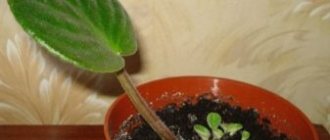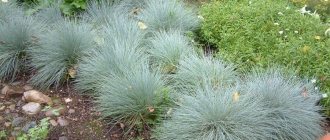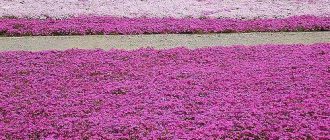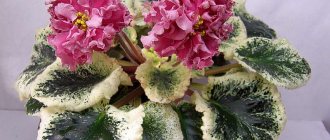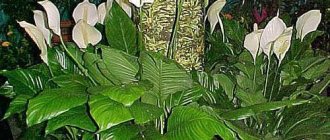What is the difference from other types?
The main difference between the plant and other varieties of spathiphyllum is its decorative form . During the flowering period, a long peduncle is located above the bush, at the tip of which a wide white blanket blooms (you can read about other varieties with white flowers here). The size of the flower is not inferior to the size of the leaves.
Spathiphyllum
09/13/2014 admin 1
Spathiphyllum
Family
- aroid.
Origin
— Philippines, Central, South America.
Love of light and high humidity are the hallmarks of spathiphyllums. In nature, their favorite places to grow are tropical forests. Mainly distributed in river valleys and along sea coasts. In nature, there are about 40 species of spathiphyllum; the home “assortment” is much more modest.
This herbaceous plant has a short stem that ends in a rosette of long oval green leaves with an elongated tip. Leaf length - up to 50 cm. Flowers - white or yellowish, externally small and inconspicuous
, collected in an inflorescence in the form of a cob. But this ear is covered with a spathe (white or yellow-green), and overall the plant looks very nice. The flowering period is quite long; the plant blooms once or twice a year.
Considering that spathiphyllum at home is extremely unpretentious and does not require care, even those who believe that “house flowers do not grow” can cope with its cultivation.
Thanks to its strict and at the same time elegant appearance, the spathiphyllum flower is widely used as an office plant. It can often be found in public places - shops, beauty salons, etc. Belongs to the same family as Alocasia.
Spathiphyllum is popularly known as “women’s happiness”, “flower of happiness”, “men’s happiness”, “flower of love”. According to signs, this flower really has miraculous powers.
It’s better not to decide, but to get this wonderful green pet. Let his magic be unnoticed!
Subvarieties and their photos
Silvio
The variety is characterized by graceful inflorescences and a lush bush. The flower size is 75 cm.
Silvio is growing fast. The surface of the leaf plate is smooth, length 30 cm, edges wavy.
Lauretta
The variety was obtained in 2001. The height of the bush is 80 cm, and the width is 85 cm. The leaves are elongated and oval in shape, have light veins, and the inflorescences are directed upward on a high petiole.
Spathiphyllum Benito
The peculiarity of an adult plant is its ability to produce up to 15 inflorescences during the flowering period. The plant is also resistant to external factors: light and excessive watering.
The size of the bush is compact, the leaves are narrow, and their length is 35 cm. Their surface is glossy and smooth.
Spathiphyllum Chico
This variety grows to large and voluminous bushes. Its height is 70-75 cm. The flowers are large, snow-white, and have the shape of a cone. The variety is easy to care for.
If you are interested in this unusual and beautiful flower, then we suggest that you familiarize yourself with other types of spathiphyllum. We will tell you in detail about growing and caring for varieties such as Strauss, Cupido, Wallis, Picasso, Alana, Domino, Sensation, Chopin, as well as varieties with red and white flowers.
Popular varieties of spathiphyllum
Active breeding work to develop new varieties of “flower-sail” began in the second half of the last century. Although they knew about it back in the 19th century, when the German scientist Gustav Wallis gave its botanical description, thereby introducing the world to a beautiful plant. Today there are about 45 types of flowers. They all have one or another distinctive feature; they can be huge in size, but there are also tiny varieties. For propagation at home, only certain types of spathiphyllum are used - they are the ones that have become the most popular among flower growers. You can see the article: Azalea: the best varieties of culture.
Spathiphyllum Wallis - the ancestor of many varieties
Named after the German botanist who first discovered this species, Spathiphyllum Wallis gave rise to many famous varieties and varieties of the flower.
All of them have earned the love of flower growers around the world for the combination of two wonderful qualities: exotic appearance and simplicity of maintenance. All varieties included in this species are small in size. Their average height does not exceed 30-40 cm. Corn-shaped inflorescences, 3-4 cm long, are surrounded by a white, sail-shaped petal, the color of which gradually turns green towards the end of flowering. The same thing happens with the arrow flower. Initially it is creamy, but then turns green along with the petal.
Chopin variety – beautiful music of nature
Spathiphyllum Chopin or Chopin is especially famous. The scientific name sounds like Spathiphyllum Chopin. The variety has become widespread, first of all, for its beauty. But ease of care also played a decisive role: Chopin spathiphyllum is not so difficult to grow at home.
Features of foliage
One of the advantages is the compactness of its bush - 35-40 cm. This allows it to be kept in rooms with different dimensions. Its appearance is classic for this culture. The elongated oval leaves are pointed at the ends. Their veins are clearly and symmetrically drawn across the entire sheet. The stripes on the leaves are deeply pressed, which creates a beautiful relief on the surface and makes the plant more decorative. Healthy foliage is rich, green, shiny, as if polished.
Flowers are the main decoration
I fell in love with this variety for the beauty of its flowers. They are bright, white, with a slight greenish tint. The sail is elongated, pointed, with veins, also painted in a delicate white-green color. It is valued for its ability to emit a pleasant, not pungent aroma in the afternoon. In order for spathiphyllum to bloom, proper care is necessary.
Variety Domino - a play of colors
Spathiphyllum Domino has a rare color for this indoor plant - its variegated, dark green, white-speckled foliage will enliven any office or living space. Despite the fact that this flower is very exclusive, it is completely unpretentious and easy to care for, so it is suitable even for beginners in floriculture. Its compactness also speaks in favor of its purchase - the bush does not grow higher than 35 cm. In the morning, graceful, white flowers with soft green veins will saturate the air with a subtle aroma, which gradually disappears by midday.
Bloom
When and how?
Flowering of spathiphyllum sweets begins at 6-7 months. The inflorescences last a long time - more than a month. Thanks to this quality, spathiphyllum flowers are perfect for cutting.
Care before and after flowering
Before flowering, the plant needs good lighting and fertilizing. You need to add compounds containing phosphorus and potassium, but reduce nitrogen-containing preparations.
Attention: water moderately as the soil dries, but not allowing it to dry out completely.
After flowering, remove the dried bud, stop adding nutrients, and water by spraying. Without this, the leaves will lose their elasticity and droop.
What to do if a flower does not produce buds?
If spathiphyllum sweet has stopped blooming, then the reasons may be as follows:
- Insufficient lighting. It is best to place the flower on the east side.
- Lack of timely watering. If the layer of soil begins to dry out, the plant will drop its buds and not bloom. It is important to control watering and use soft, settled water.
- Incorrectly selected pot. You should not use containers that are too large, since flowering is only possible if the roots occupy the entire space of the pot.
Home care
Selecting a location
It is advisable to grow the plant on windows facing north, east or west. Spathiphyllum Sweet needs good lighting, but not in direct sunlight.
What should the soil be like?
The flower prefers loose, nutritious soil with a neutral pH level. To prepare the soil, mix the following components in equal proportions:
- peat;
- humus;
- river sand;
- leaf and turf soil.
Landing
Planting activities are carried out in late February - early March.
Procedure:
- Place drainage at the bottom of the container and fill it with nutrient soil.
- Scatter planting material in the form of seeds over the surface of the ground, slightly deepening it.
- Spray the soil with water from a spray bottle and cover the plantings with polyethylene.
- Remove the cover every day for ventilation.
- The first shoots appear after 10 days, then remove the film and move the container to a lighted place.
- As soon as 2-3 leaves are formed, pick.
Temperature
In summer, during the flowering of spathiphyllum retinue, temperature indicators should be 22-24 degrees Celsius, and in winter – 16-17 degrees.
If the temperature drops to 13 degrees, the flower will slow down.
Watering
For moistening, use only settled water. The flower prefers abundant watering , which should be done 2-3 times a week. Pour water carefully so that it only hits the soil.
It is also important to spray, otherwise the leaves will begin to dry out. This needs to be done 2 times a day. In winter, moisten the soil once a week.
Top dressing
Apply nutritional compositions from March to September. Use mineral complex preparations. The solution should be slightly concentrated - 1 g per 1 liter of water. Before and after this procedure, water the flower thoroughly.
Apply fertilizing once every 2 weeks. For good and long flowering, use fertilizers with a predominance of potassium and phosphorus.
Trimming
After flowering, be sure to cut off the peduncle , otherwise it will absorb nutrients. Carry out pruning as close to the rhizome as possible. Dry and diseased leaves of the crop must also be removed. Treat all cut areas with crushed coal.
Transfer
Similar events are carried out in the spring, when the rhizome has grown to cover the entire pot. Since the roots are fragile, use the transshipment method, removing only a small part of the soil from the root system. If the rhizome begins to rot, then clean it up.
Take a pot a little larger than the previous one, be sure to take care of drainage. During the rooting period, reduce watering, and also cover the flower with polyethylene and ventilate 2 times a day.
How to propagate?
Cuttings
It should be carried out in spring or summer. Procedure:
- Cut off the leaf rosette and place in water. You can use raw sand. Wait until roots form.
- If they are already formed, then direct planting into the ground can be carried out.
Dividing the bush
It is better to divide the spathiphyllum bush in the spring. The separated part of the plant should have 3 strong leaf rosettes and part of a healthy rhizome.
Deepen the cuttings to the same depth as in the previous pot. Before dividing, soak the roots with water, wash them and untangle them. Then clean and powder the sections with crushed charcoal.
Seeds
Procedure:
- Plant the planting material in a container with moist soil, which consists of sand and peat. Cover the seedlings with polyethylene.
- Maintain soil moisture by spraying.
- Open the film every day until seedlings form.
- Plant them in separate containers when 2-3 leaves are formed.
Beautiful examples
In residential premises, culture acts as a decorative item. Plants are planted in snow-white pots of various geometric shapes, emphasizing the color of the bracts and highlighting the rich tone of the foliage.
Flowers can be planted in groups in wide planting containers. This method is used to visually divide space into zones in residential and office premises, as a decoration for various massive interior items: dining tables, chests of drawers, and so on.
In landscape design, spathiphyllums act as a border or flower arrangement. They require high-quality soil drainage, its composition and care as the plant grows.
An overview of the types of spathiphyllum is presented in the following video.
Spathiphyllum is a stemless perennial from the tropics. Most flowers similar to spathiphyllum belong to the araceae family. This group includes decorative foliage and beautiful flowering plants.
Diseases and pests
Most often, diseases affect the leaf blade, resulting in the following problems:
- Yellowness of leaves. It occurs when watering is infrequent and the humidity in the room is too low.
- Drying and curling of leaf tips. This problem occurs when there is insufficient humidity and cold air.
- Pale leaves. The reason is that the lighting is too bright.
- Leaves may turn black if the root system is diseased. And this happens as a result of excess moisture. Also, blackness on the leaf plate is the result of unbalanced fertilizing.
Dangerous pests include:
Spider mite. It is located on the inside of the leaves, enveloping it in a cobweb. After a while, the leaf plate dries out. To combat, use a soap solution, only first clean the leaves from cobwebs. Onion solution (100 g of peel and 5 liters of water) is also effective.- Aphid. It settles at the bottom of the leaf blade. This insect is characterized by rapid reproduction. It feeds on the sap of the plant, causing the leaves to curl. To combat, use a solution of nicotine sulfate (1 g per 1 liter of water).
- Shield. It covers the leaf blade with dark spots. For processing, a soap solution with the addition of kerosene and tobacco is used.
The history of the origin of giant varieties with large leaves
Large spathiphyllums were developed about 50 years ago for landscaping shaded buildings. They reach a length of more than 1.5 m and tolerate partial shade perfectly. The plants lack a stem. Huge leaves occupy 90 cm of the entire height of spathiphyllums. They reach a width of 40 cm. A spectacular white flower 30-35 cm long is located in the center of the plant.
The first flower was found and described in detail by the German biologist Gustav Wallis in the 19th century. Then the plant became popular in European countries and Colombia. The flower immediately fell in love with many breeders, who subsequently developed the Alan variety.
READ MORE: Maunfeld oven features electric and gas models How to choose a built-in oven with a microwave function
Prevention of various problems
The following recommendations will help prevent the development of problems when growing spathiphyllum:
- The flower responds positively to moisture, so water it abundantly. But it is important not to overdo it, as excessive watering will cause the leaves to turn black and yellow.
- The plant does not like direct sunlight, but it cannot live without sunlight. So it is important to find a place with diffused light.
- Spathiphyllum suite does not like drafts and sudden changes in temperature. In summer the temperature should be 18 degrees, and in winter 16 degrees and not lower.
Spathiphyllum Sweet is a plant that is chosen for home cultivation. Its peculiarity is its long and beautiful flowering. But this can only be achieved with careful care. In addition to stimulating flowering, this will prevent the development of diseases.
Plants for a children's room: spathiphyllum: 4 comments
What a cool flower! As soon as we renovate the nursery, I will put spathiphyllum, hyacinth, and myrtle there, on your advice!
Hyacinth should not be placed in the nursery; it has a very strong smell and can cause headaches. It's better to leave it in the common room and enjoy it during the day.
I bought this flower a year ago. I can only say one thing, it is very unpretentious and pleases with its new shoots, and of course flowers.
I just read on another site that spathiphyllum is poisonous and if a child accidentally swallows a piece of the plant, there may be problems, 10 houseplants that are deadly for health. It is unlikely that there is at least one living space where there are no indoor plants. They decorate homes, fill them with comfort and, as many believe, clean the air of toxic substances, electromagnetic radiation and harmful bacteria. However, scientists have found that some types of decorative flowers can cause significant harm to the health of humans and domestic animals. The choice of indoor plants must be approached very responsibly, especially if there are small children in the house. In nature, there are a lot of household flowers that are dangerous to health, but during tests, doctors identified 10 plants that should be gotten rid of first:
Sansevieria (Mother-in-law's tongue). Although it does an excellent job of purifying the air, it should still be avoided. This plant can cause nausea, excessive salivation and sore throat.
Aloe Vera
Everyone knows the beneficial properties of aloe, but you should remember one very important rule - it should not be used internally. This will lead to intestinal irritation
And if this is not very dangerous for humans, then for animals such experiments can end very sadly.
Spathiphyllum. Causes allergic reactions. Once in the human body, it leads to swelling of the mouth, tongue, and lips. In more severe cases, it can cause death.
Spathiphyllum is a plant with bright, glossy foliage and unusually shaped flowers that will gracefully and elegantly decorate any room. It belongs to the tropical, evergreen representatives of the Araceae family. Some call it the “white sail” for its resemblance to a ship’s sail. Sometimes you can find another name - spathiphyllum Women's Happiness, as it is believed that it will be the best gift for a woman.
